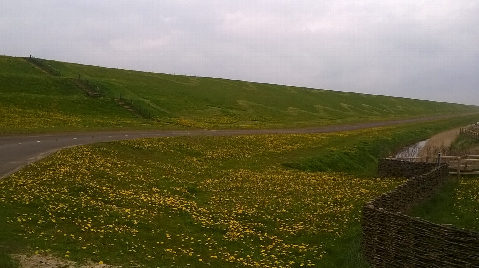Mowing and biodiversity
Mowing and biodiversity
Biodiversity is not doing well. Mowing is necessary, but it remains a major intervention for flora and fauna. Gains can be made by taking more account of the habitat of plants and animals. By signing Green Capital 2015, the Motion to Maintain Insects and Green Deal Infranature, we as a water board have promised to make an effort for biodiversity in our working area. Therefore, depending on the location, we mow later and/or less whereby different mowing strategies are followed. For all mowing activities, however, safety and function must always be guaranteed and the legislation for nature protectionOmgevingswet) must not be violated.
Room for growth in the water
In the water system we focus on room for growth. Where the watercourse is wider than necessary, aquatic and riparian plants are given more space by mowing less.
Nature-friendly banks

Nature-friendly banks are mowed in stages with large areas of vegetation remaining. These banks consist of wet wide shallow zones with aquatic vegetation protruding below and above the water. The wider this zone from open water to dry slope the higher the biodiversity. Nature-friendly banks form "the home of the fish" and if this is in order the rest of the other species such as aquatic insects and amphibians will come naturally. The present plant structure forms an attachment point for fish eggs and a hiding place for young fish spawn, for example against pike eating. The drier (reed) zone forms "the home of birds and small (mammals). In spring, perennial reed is needed for nest-building by reed warblers, among others.
Hayland management: room for more species variation
To improve biodiversity, we will start hay meadow management (mowing and removal) on 200 ha of the dikes in 2020. By removing grass clippings after each mowing, fewer nutrients enter the soil, the underlying vegetation does not suffocate and lighter and more varied vegetation (and fauna) can develop. We apply hay meadow management mainly to dikes that form an ecological connecting zone between different nature areas.
Flowery dikes
To give nature a helping hand, we are seeding some dikes with a flower/herb mixture appropriate to the North Holland dikes. Flower-rich dikes provide a seed source for further dispersal. A species-rich turf with flowers, in addition to providing a greater food supply for insects, has a more diverse root structure underground and contributes to erosion resistance. And is more resistant to prolonged drought. A flower-rich levee is a safe levee!
Sinus mowing
Sinus management is insect-friendly management on the dike that forms a ribbon across the agricultural landscape. It is a 'winding way of mowing' in which we leave half of the vegetation in the first round of mowing (from June 15). And in the second round of mowing (mid-August), at the foot of the dike, the other half, so that the transition between the two mowings takes place organically. This creates a varied vegetation. We apply this method of mowing on the Assendelverzeedijk and on the Hondsbossche Zeewering. In both cases these are dikes that no longer have a flood defense function, allowing us to experiment.